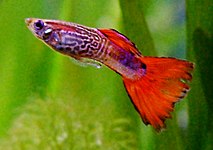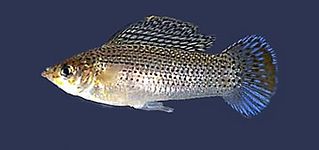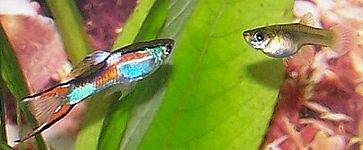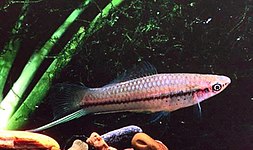| Revision as of 19:40, 5 November 2005 editNeale Monks (talk | contribs)Extended confirmed users4,124 edits →Aberrant livebearers← Previous edit | Latest revision as of 10:49, 10 January 2025 edit undoSurtsicna (talk | contribs)Autopatrolled, Extended confirmed users131,477 editsNo edit summary | ||
| (211 intermediate revisions by more than 100 users not shown) | |||
| Line 1: | Line 1: | ||
| {{Short description|Fish that give birth to free swimming offspring}} | |||
| '''Live-bearing aquarium fish''', often simply called '''livebearers''' are ] that retain the eggs inside the body and give birth to live, free-swimming young. Because the newborn fish are relatively large, typically around 10 mm in length, they are easier to feed than newly hatched fry of egg-laying species such as ] and ]. This makes them much easier to raise. In addition, being much bigger they are also far less vulnerable to predation, and are often able to swim and hide effectively even in quite densely stocked ]. Livebearers are consequently among the very first fish aquarists are able to breed. | |||
| ] fry]] | |||
| '''Livebearers''' are ] that retain their eggs inside the body and give birth to live, free-swimming young. They are especially prized by aquarium owners. Among aquarium fish, livebearers are nearly all members of the family ] and include: ], ], ] and ]s.<ref name="Alderton2012">{{cite book|url=https://books.google.com/books?id=BKIKBgAAQBAJ|title=Livebearers: Understanding Guppies, Mollies, Swordtails and Others|author=David Alderton|date=15 May 2012|publisher=CompanionHouse Books|isbn=978-1-62008-006-1}}</ref> | |||
| The advantages of livebearing to the aquarist are that the newborn ] are larger than newly-hatched fry, have a lower chance of mortality and are easier to care for. Unusual livebearers include ]s and ], where the males care for the young, and certain ]s that are ]s, with the parent incubating the eggs in the ]. | |||
| ==Common aquarium livebearers== | ==Common aquarium livebearers== | ||
| <!-- These aren't common and should not be listed under common! And not all sharks and rays are livebearers. The ], ], and many types of ] and ] are all livebearing fish, aquarists do not usually keep these.-->Species of interest to aquarists are almost always members of the family ], most commonly ], ], ], ], ], and ]. Most of these are ], with the developing embryos receiving no nourishment from the parent fish, but a few are ], receiving food from the maternal blood supply. {{Cn|date=April 2021}} | |||
| Because the newborn fish are large compared to the fry of ] fish, <!-- Added clarification to oviparous.-->which are those that lay eggs, newborn fish of livebearers are easier to feed than the fry of egg-laying species, such as characins and cichlids. This makes them much easier to raise, and for this reason, aquarists often recommend them for beginning fish breeder hobbyists.<!-- Minor language changes and clarifications added.--> The larger livebearer fry makes them far less vulnerable to predation, as the parents often eat fry if hungry. With the sufficient cover in the way of plants or porous objects, they can sometimes mature in a community tank.<ref>{{Cite web |title=Livebearers: Raise Guppies, Mollies, Platies & Swordtails in your Aquarium |url=https://www.liveaquaria.com/article/257/?aid=257 |access-date=2022-09-08 |website=www.liveaquaria.com}}</ref> | |||
| The ], ], and many types of ] and ] are all livebearing fish, these are not usually kept by aquarists. Instead, the species of interest to aquarists are almost always members of the family ''']''', most commonly ], ], ] and ]. A few other genera from this family are kept by advanced aquarists, including ], ], ], and ]. | |||
| ==Rare livebearers== | |||
| A few other families include livebearing species kept by aquarists, though far less commonly than the Poecilidae. These include the '''splitfins''', family ]; the '''halfbeaks''', family ]; and the '''four-eyed fish''' ], family ]. Freshwater stingrays of the family ] are sometimes kept by advanced aquarists, and these are also livebearers. | |||
| None of these are considered to be easy aquarium fish, and some present as much of a challenge to the aquarist as egg-laying fish. Commonly, the problems include providing the right diet and conditions to trigger mating, and ensuring that the female does not ] the developing embryos too soon. | |||
| ==Ovoviviparous and viviparous fish compared== | ==Ovoviviparous and viviparous fish compared== | ||
| ⚫ | Most of the Poeciliidae are ], that is, while the eggs are retained inside the body of the female for protection, the eggs are essentially independent of the mother and she does not provide them with any nutrients. In contrast, fish such as splitfins and halfbeaks are ], with the eggs receiving food from the maternal blood supply through structures analogous to the ] of ].<ref>{{Cite book |last=Blackburn |first=D.G. |url=https://www.worldcat.org/oclc/1045069010 |title=Viviparity and oviparity: evolution and reproductive strategies |date=2018 |work=Encyclopedia of reproduction. Volume 1, Male reproduction |others=Michael K. Skinner |isbn=978-0-12-815145-7 |editor-last=Jégou |edition=2nd |location=Oxford |pages=994–1003 |oclc=1045069010}}</ref> | ||
| ⚫ | Most of the |
||
| ==Aberrant livebearers and mouthbrooders== | ==Aberrant livebearers and mouthbrooders== | ||
| ⚫ | ]s and ] can be defined as livebearers, although in these cases the males incubate the eggs rather than the females. In many cases, the eggs are dependent on the male for oxygen and nutrition so these fish can be further defined as viviparous livebearers. {{Cn|date=April 2021}} | ||
| Many ]s are ]s, with the female (or more rarely the male) incubating the eggs in the mouth. Compared with other cichlids, these species produce fewer but bigger eggs, and when they emerge, the fry is better developed and has higher survivability. Because the eggs are protected from the environment but do not absorb nutrients from the parent, this condition is ] to, though not ] with, ovoviviparity.{{Cn|date=April 2021}} | |||
| ⚫ | ] and ] can be defined as livebearers, although in these cases |
||
| ==Livebearer fish gallery== | |||
| Many ] are ''']''', with the female (or more rarely the male) incubating the eggs in the ]. Since the eggs are invariably large and fewer in number than is the case with species that lay their eggs in nests, once the young fish emerge they are larger and more highly developed than is typical for cichlids are so relatively durable and easy to raise. The eggs do not absorb nutrients from the parent and the fry are not released until they are large and comparatively well developed. This condition is ] to, though not ] with, ovoviviparity. A wide range of other fish are also known to be mouthbrooders, including ] and ], though these are less commonly kept in aquaria. | |||
| <gallery heights="100px" mode="packed"> | |||
| Image:Guppy-male.jpg | |||
| Image:Poecilia latipinna.jpg | |||
| Image:Poecilia reticulata 01.jpg | |||
| Image:Xiphophorus helleri 03.jpg | |||
| Image:Dermogenys sumatrana 02.jpg | |||
| </gallery> | |||
| ==References== | |||
| {{Reflist}} | |||
| ==External links== | ==External links== | ||
| ⚫ | * | ||
| ⚫ | * | ||
| ⚫ | * Includes growth rate chart and pictures of newborn fish. | ||
| * | |||
| ⚫ | ] | ||
| * | |||
| ⚫ | ] | ||
| ⚫ | * | ||
| ] | |||
| ⚫ | * | ||
| ] | |||
| ⚫ | * Includes growth rate chart and pictures of newborn fish. | ||
| ⚫ | ] | ||
| ⚫ | ] | ||
Latest revision as of 10:49, 10 January 2025
Fish that give birth to free swimming offspring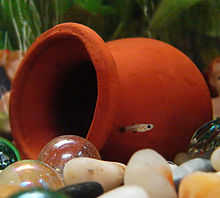
Livebearers are fish that retain their eggs inside the body and give birth to live, free-swimming young. They are especially prized by aquarium owners. Among aquarium fish, livebearers are nearly all members of the family Poeciliidae and include: guppies, mollies, platies and swordtails.
The advantages of livebearing to the aquarist are that the newborn juvenile fish are larger than newly-hatched fry, have a lower chance of mortality and are easier to care for. Unusual livebearers include seahorses and pipefish, where the males care for the young, and certain cichlids that are mouthbrooders, with the parent incubating the eggs in the buccal cavity.
Common aquarium livebearers
Species of interest to aquarists are almost always members of the family Poeciliidae, most commonly guppies, mollies, platies, swordtails, Endler's livebearer, and mosquitofish. Most of these are ovoviviparous, with the developing embryos receiving no nourishment from the parent fish, but a few are viviparous, receiving food from the maternal blood supply.
Because the newborn fish are large compared to the fry of oviparous fish, which are those that lay eggs, newborn fish of livebearers are easier to feed than the fry of egg-laying species, such as characins and cichlids. This makes them much easier to raise, and for this reason, aquarists often recommend them for beginning fish breeder hobbyists. The larger livebearer fry makes them far less vulnerable to predation, as the parents often eat fry if hungry. With the sufficient cover in the way of plants or porous objects, they can sometimes mature in a community tank.
Ovoviviparous and viviparous fish compared
Most of the Poeciliidae are ovoviviparous, that is, while the eggs are retained inside the body of the female for protection, the eggs are essentially independent of the mother and she does not provide them with any nutrients. In contrast, fish such as splitfins and halfbeaks are viviparous, with the eggs receiving food from the maternal blood supply through structures analogous to the placenta of placental mammals.
Aberrant livebearers and mouthbrooders
Seahorses and pipefish can be defined as livebearers, although in these cases the males incubate the eggs rather than the females. In many cases, the eggs are dependent on the male for oxygen and nutrition so these fish can be further defined as viviparous livebearers.
Many cichlids are mouthbrooders, with the female (or more rarely the male) incubating the eggs in the mouth. Compared with other cichlids, these species produce fewer but bigger eggs, and when they emerge, the fry is better developed and has higher survivability. Because the eggs are protected from the environment but do not absorb nutrients from the parent, this condition is analogous to, though not identical with, ovoviviparity.
Livebearer fish gallery
References
- David Alderton (15 May 2012). Livebearers: Understanding Guppies, Mollies, Swordtails and Others. CompanionHouse Books. ISBN 978-1-62008-006-1.
- "Livebearers: Raise Guppies, Mollies, Platies & Swordtails in your Aquarium". www.liveaquaria.com. Retrieved 2022-09-08.
- Blackburn, D.G. (2018). Jégou (ed.). Viviparity and oviparity: evolution and reproductive strategies. Michael K. Skinner (2nd ed.). Oxford. pp. 994–1003. ISBN 978-0-12-815145-7. OCLC 1045069010.
{{cite book}}:|work=ignored (help)CS1 maint: location missing publisher (link)
External links
- American Livebearer Association
- British Livebearer Association
- Keeping & Breeding Halfbeaks Includes growth rate chart and pictures of newborn fish.
- How to Keep Livebearers
